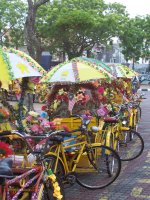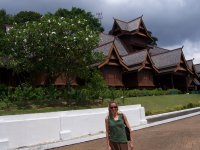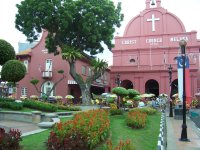Colonial influences in Melaka, Malaysia
I recently wrote a post about how much I enjoyed my time in the Malaysian capital of Kuala Lumpur. While I was there, I decided to take a day trip to explore the city of Melaka (also known as Malacca), a two hour drive south of the Malaysian capital and a UNESCO Heritage site.
Melaka has a rich past, with an eclectic mix of cultural influences on its urban planning from the various colonial powers that ruled the city over the centuries.
The town of Melaka, formerly a tiny fishing village, was founded in 1400 and said to be named for the local malacca tree.
Located at a strategic point along the Strait of Malacca, and just a few kilometers from Sumatra, Indonesia, Melaka was of interest to European colonial powers in the region.
 By the 15th century, it had grown into one of the richest trading centers in the east.
By the 15th century, it had grown into one of the richest trading centers in the east.
In 1511, Melaka fell to the Portuguese. In 1641, the Dutch became its colonial rulers.
And in 1824 it was the turn of the British, when the growing city was ceded to them in the Anglo-Dutch Treaty of that year. Malaya (which includes modern-day Malaysia and Singapore) was never actually a British colony, but a protectorate, initially overseen by the British East India Company. There was a brief period of Japanese occupation during World War II, but no remnants of that period remain.
With this jumble of cultures and influences mixed with the native Malay culture and the Malaysian populations of ethnic Chinese and Indians, the city is a well-preserved treasure trove of jumbled architectural styles and lots of fun to explore. The traditional tuks are a good way to get around the city. Enjoy the architecture and the Chinese pagodas and Indian temples.
The only remaining remnant of the Portuguese fortress if the Porta de Santiago, one of the four remaining gateways into the Portuguese A’Famosa fortress, built in 1512.
The Stadthuys was built during Dutch rule in the 1650s and served as the seat of Dutch administration…. a little corner of Holland in sweltering southeast Asia. The Christ Church was also built on the square by the Dutch in 1753 to celebrate one hundred years of their rule. Under the English, it became an Anglican church in 1838. Inside, there is a mixture of Dutch and English tombstones.
The sultan’s palace is a recreation of the 15th century Malacca Sultanate Palace. Today, it houses the Cultural Museum. Unfortunately, during my visit, I didn’t have time to visit. It will have to be for next time.
I loved my day in Melaka and the jumble of Portuguese, Dutch and English architecture, standing beside modern Malay, Chinese and Indian buildings and places of worship.
Melaka is a wonderful place to visit during your stay in Kuala Lumpur. Frequent buses run from Kulala Lumpur to Melaka. You can also arrange for day trips with a driver.
With limited time, I opted for the latter option and wound up taking the tour with an extremely nice Australian woman who spent her childhood in Malaysia and hadn’t been back since they left at Malaysian independence, in 1963.
If you’re looking for a good novel covering this era, read Anthony Burgess, of Clockwork Orange fame, specifically his excellent The Malayan Trilogy.
Enjoy your time in beautiful Melaka!




Wow, I would be very curious to read Burgess’ book. I’ve never travelled through Malaysia and miss Asia so much! It’s rather incredible to see the succession of colonial masters in the form of competing monuments. In West Africa it’s much the same though sadly most building were fortresses which were key to the slave trade. This post makes me feel like taking a trip somewhere!
buildings! Oops
Hi Catherine. Yes, Burgess’ book is excellent. He lived for a long time in ‘Malaya’, as it was known then, and spoke the language well. Yes, all the colonial architecture is a bit disconcerting in the tropical environment. It’s the same in Vietnam, with all the French architecture.
I’m guessing you’re the same, Catherine, but I always want to take a trip somewhere. : ) Reading about it is the next best thing…
I’m learning a lot from this blog post. Very interesting. The architecture is a connection to the past. I also like the different colors and shapes of all those buildings.
Thanks, Julia. Yes, it’s a real jumble of architectural styles and quite amazing to see remnants of three colonial eras in one city… plus Malay mosques, Buddist temples from the Chinese minority and Hindu temples from the Indian minority. Lots to enjoy!
[…] I recently wrote a post about how much I enjoyed my time in the Malaysian capital of Kuala Lumpur. While I was there, I decided to take a day trip to explore the city of Melaka (also known as Malacca), a two hour drive south of … […]
[…] See on kimberlysullivan.wordpress.com […]
[…] If you’re planning a trip to beautiful Malaysia, be sure to look at my earlier posts on Kuala Lumpur and Melaka. […]
[…] you’re travelling in Malaysia, see my earlier posts on the colonial past in Melaka, and the not-to-be-missed E&O Hotel in […]